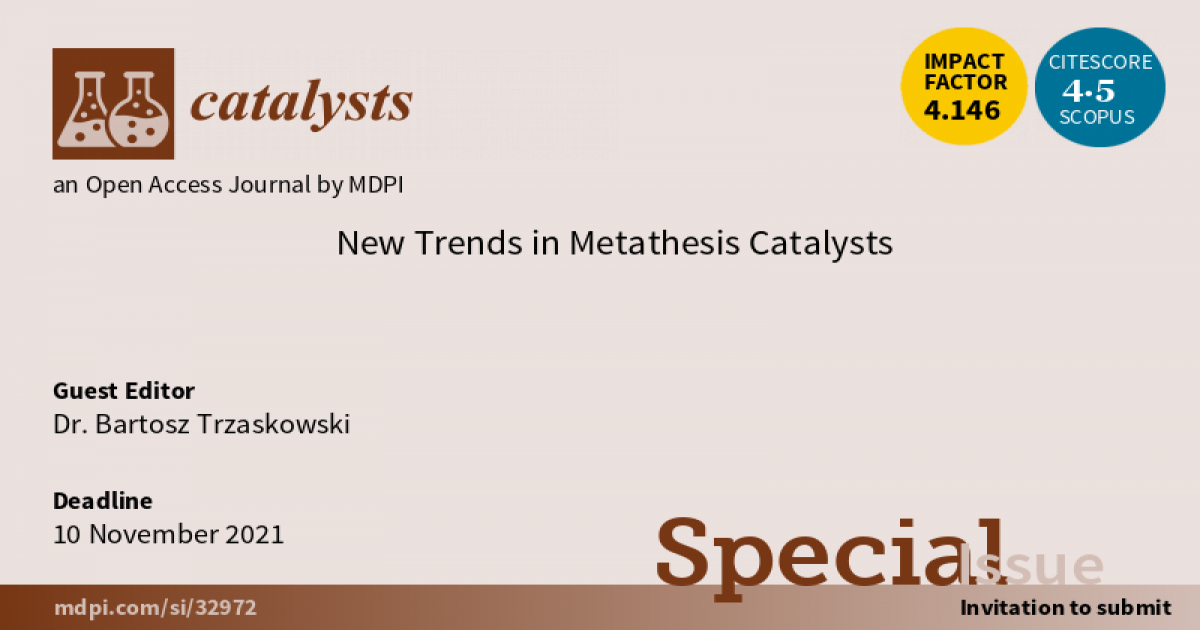New Trends in Metathesis Catalysts
A special issue of Catalysts (ISSN 2073-4344). This special issue belongs to the section "Catalysis in Organic and Polymer Chemistry".
Deadline for manuscript submissions: closed (10 November 2021) | Viewed by 35486

Special Issue Editor
Interests: computational chemistry; catalysis; molecular modeling; nanoscience; physical and organic chemistry; olefin metathesis; green chemistry
Special Issues, Collections and Topics in MDPI journals
Special Issue Information
Dear Colleagues,
More than 20 years after the development of the first well-defined ruthenium metathesis catalyst, this topic remains one of the hottest branches in chemistry and catalysis. Recent advances in this field include novel catalysts, ring-opening metathesis polymerization, the use of green solvents and aqueous metathesis catalysts, mechanistic studies on catalyst decomposition, Z-selective or photoactivated catalysts, the use of mechanochemistry in the synthesis of ruthenium catalysts, and many others. This Special Issue of Catalysts aims to provide an overview of the latest progress in Ruthenium Metathesis Catalysts with the goal of presenting the most recent scientific results in this field. We welcome both experimental and computational contributions, including full papers, communications, and reviews.
Dr. Bartosz Trzaskowski
Guest Editor
Manuscript Submission Information
Manuscripts should be submitted online at www.mdpi.com by registering and logging in to this website. Once you are registered, click here to go to the submission form. Manuscripts can be submitted until the deadline. All submissions that pass pre-check are peer-reviewed. Accepted papers will be published continuously in the journal (as soon as accepted) and will be listed together on the special issue website. Research articles, review articles as well as short communications are invited. For planned papers, a title and short abstract (about 100 words) can be sent to the Editorial Office for announcement on this website.
Submitted manuscripts should not have been published previously, nor be under consideration for publication elsewhere (except conference proceedings papers). All manuscripts are thoroughly refereed through a single-blind peer-review process. A guide for authors and other relevant information for submission of manuscripts is available on the Instructions for Authors page. Catalysts is an international peer-reviewed open access monthly journal published by MDPI.
Please visit the Instructions for Authors page before submitting a manuscript. The Article Processing Charge (APC) for publication in this open access journal is 2200 CHF (Swiss Francs). Submitted papers should be well formatted and use good English. Authors may use MDPI's English editing service prior to publication or during author revisions.
Keywords
- olefin metathesis
- catalysis
- ruthenium
- reaction mechanism
- polymerization
- decomposition
- N-heterocyclic carbenes
Benefits of Publishing in a Special Issue
- Ease of navigation: Grouping papers by topic helps scholars navigate broad scope journals more efficiently.
- Greater discoverability: Special Issues support the reach and impact of scientific research. Articles in Special Issues are more discoverable and cited more frequently.
- Expansion of research network: Special Issues facilitate connections among authors, fostering scientific collaborations.
- External promotion: Articles in Special Issues are often promoted through the journal's social media, increasing their visibility.
- Reprint: MDPI Books provides the opportunity to republish successful Special Issues in book format, both online and in print.
Further information on MDPI's Special Issue policies can be found here.





